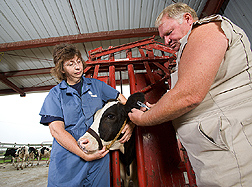This page has been archived and is being provided for reference purposes only. The page is no longer being updated, and therefore, links on the page may be invalid.
|
Read the magazine story to find out more. |
|
|
New Approaches Needed To Fight This Cattle Virus
By Luis PonsJanuary 10, 2006
Agricultural Research Service (ARS) scientists are ready to take to the next level efforts to eradicate the bovine viral diarrhea virus (BVDV).
BVDV causes animal diseases that affect reproduction and nutrition, milk production and respiratory function. Pregnant cows that are infected can have spontaneous abortions or give birth prematurely, while calves born with BVDV may be persistent carriers that can infect additional herds.
There's no treatment for BVDV, which costs U.S. cattle producers millions of dollars in losses each year.
According to microbiologist Julia Ridpath of ARS’ National Animal Disease Center in Ames, Iowa, decades of vaccination and voluntary control programs aimed at eliminating the virus from the United States have not worked.
Also at Ames, microbiologist John Neill is applying a method that detects alterations in cancer cells in humans toward understanding disease mechanisms in animals infected with the virus.
An extensive management program encompassing vigilance, biosecurity education and continued research is needed, according to Ridpath. She recently launched a study with the Northeast Iowa Community-Based Dairy Foundation in Calmar, focusing on newborn calves’ response to BVDV vaccination. This study is the subject of a cooperative research and development agreement that runs through 2006.
Meanwhile, Neill is applying serial analysis of gene expression (SAGE) -- a technology developed in the mid-1990s for detecting gene-expression alterations that tell how cancer cells differ from normal cells -- against BVDV.
Neill is using SAGE to compare cattle gene expression in normal cells to that in BVDV-infected cells. He’s also studying the pathology and immunosuppressive properties of the virus -- work that may lead to a simple serum test for rapidly detecting persistently infected animals and improved vaccines.
Read more about the research in the January 2006 issue of Agricultural Research magazine.
ARS is the U.S. Department of Agriculture's chief scientific research agency.

